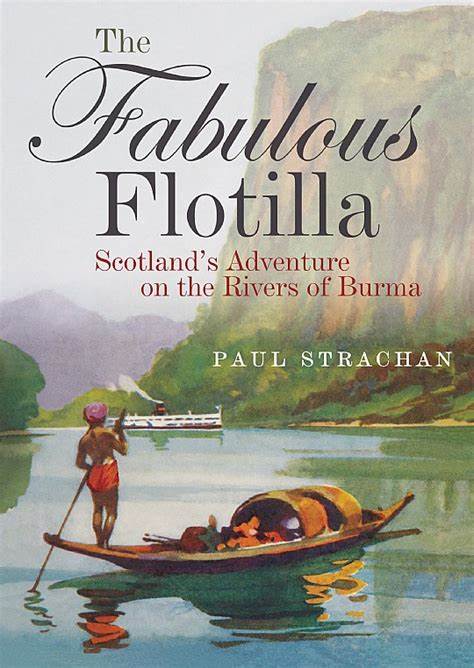
The Fabulous Flotilla; Scotland’s Adventure on the Rivers of Burma. By Paul Strachan. Whittles Publishing, Dunbeath, Caithness, Scotland, 2023
Reviewed by Tim Coyle
The historical British Empire (on which the sun never set), has attracted criticism in recent years among some circles in former colonies over human rights abuses and economic rapacity. While such criticism may be valid, other facets of British colonialism brought measurable benefits; none more so than the subject of this book – The Irrawaddy Flotilla Company (IFC) -The Fabulous Flotilla in Burma.
Most people associate the English as the imperialists who oversaw the vast empire. In the case of Burma and the IFC, it was an almost wholly Scottish undertaking, entirely free of corruption, political oppression, or indeed racism. From the mid-nineteenth century to its self-destruction in the face of Japanese invasion in 1942, the IFC opened Burma to trade and travel, providing prosperity to its citizens. It was never a colonial government monopoly, nor a member of a cartel, although it enjoyed a semi-official status with the colonial government in Rangoon. It was exclusively managed by Scots, at the commercial and operational levels. At its peak the IRC operated up to 600 vessels, some so huge they could accommodate over 3000 passengers. The vessels were designed and laid down in Scottish yards, such as Denny of Dumbarton and Yarrow, for the mighty Irrawaddy, Chindwin and the Salween rivers, and were sailed (the larger ones) or ‘flat packed’ for assembly in the in-country IFC yards.
The First, Second and Third Anglo-Burmese Wars (1824, 1852 and 1885 respectively), were messy little colonial wars over assertion of power between the British and local kings – both sides misunderstanding each other – typical for the time. River vessels were employed for military operations, and it was in this environment that the roots of the IFC emerged. By the late 1880s, the IFC had transitioned from support to military operations to become an indispensable asset of Burmese national development.
The author, Paul Strachan, is an old Burma ‘hand’. He first went to Burma in the 1980s to work for an engineering company but fell under the spell of this fascinating, lost company and the country it served. He formed a river ship tourism venture based on the old company. As a Scot, a river ship commander and business owner and an expert on Burmese culture, art and architecture, his love of the country and its history is clearly felt in reading The Fabulous Flotilla. The book is divided into two parts: The ‘Irrawaddy Flotilla Company’ and ‘A River Voyage in the 21st Century’.
In Part One, the narrative of The Irrawaddy Flotilla Company begins in the Wars, then passes to details of the river ships, the business management and the vessel commanders who, as will be imagined, were ‘colourful’. He then takes us on ‘A voyage on an IFC Ship’ in the glory years and concludes with the hair-raising hazards met by IFC commanders on the mighty Burmese rivers.
In Part Two, we journey with Strachan on a River Voyage in the 21st Century. He takes us from Rangoon and the Delta through Middle and Royal Burma to the Upper Irrawaddy, the Chindwin and the Salween.
The river ships were generally of generous beam with draughts of two to three feet. They usually had ‘flats’ (barges) lashed along both sides. In the larger ships, first class was accommodated in individual cabins forward with appropriate lounge facilities, with second- and third-class accommodations in descending order of salubriousness. Third class was virtually open decks across which the maximum of humanity and animals were distributed, in no particular order. Ship commanders enjoyed a level of prestige and respect in accordance with the protocols of the time. However, their responsibilities were demanding as they were constantly on duty when the vessel was underway. An IFC commander’s wife (E.M. Powell-Brown), in a book she wrote in 1911 entitled A Year on the Irrawaddy, described the conditions under which the river skippers had to work. This extract from her book is reproduced in The Fabulous Flotilla:
‘Picture for yourself a vessel of tremendous beam with an equally broad flat on either side steaming through a zig zag channel scarcely wider than the steamer and flats, with a hurrying tide helping them along and tantalizing little boats scudding across the pathway. Imagine what endeavours are needed to prevent the flats smashing into the bank as they swing around a sharp corner. Think of the accumulated difficulties when the Commander sees a similar vessel bearing down on him from the opposite direction and a warning ‘by your leave’ from another ship overtaking him and you will get some faint idea of the state of mind of the skipper as he steers the vessel through the creek.’
Part Two takes the reader on a 21st century voyage on the three rivers. Strachan expresses his lifelong affection for Burma and its people in the way he describes the ancient temples and terrain along the rivers. At the same time, he decries the environmental degradation of mass teak forest clearing, plastic pollution and ancient towns disfigured by ugly ‘modern’ buildings. Strachan ascribes these examples of rampant greed to the corruption of military-owned commercial undertakings, largely fed by Chinese influence and money. Strachan, while obviously keenly affected by these ruinations, is restrained in his comments; his narrative largely celebrates the wonders of the old country and its geography and culture while sadly acknowledging its gradual disintegration.
The reader can sense Strachan’s personal dedication to his subject. The Fabulous Flotilla covers Burmese Raj history, period riverine operations and past and present Burmese art, architecture and geographic wonders of this ancient land. I thoroughly recommend it.



